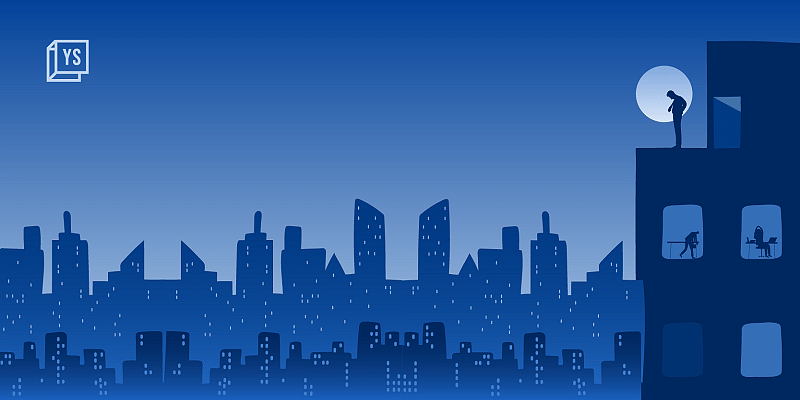(Trigger warning: Story mentions suicide)
While mental health in workplaces has gained considerable currency in recent times, there is still a need for mainstreaming conversations. But even within that marginalised mental health space, suicide inhabits a silo of its own, often distinguished by a conspicuous culture of silence and taboo.
This is not to suggest that suicide is a workplace-driven phenomenon.
However, since workplace challenges are globally acknowledged as one of the contributing factors leading to suicidal ideation or completed suicides, it is worth the time.
“Suicide is a very disquieting word. It has a similar effect like cancer had 20 years ago. The underlying thought is that it’s the end of the world… It’s an extreme word,” explains Sangeeta Chandran, Head, Safety and Well Being Programmes at Tata Consultancy Services (TCS). A certified integrative therapy counsellor, Sangeeta is the Global Head of TCS Cares, a mental health and well-being programme established in 2018.
The global cost of mental ill-health through lost productivity, absences, and staff turnover is estimated to be around $2.5 trillion annually. The World Health Organisation (WHO) estimates that India will suffer economic losses amounting to a staggering $1.03 trillion from mental health conditions between 2012 and 2030.
Dr Jini K Gopinath, Chief Psychology Officer of mental health startup YourDOST, says: “Suicide is not just a psychological issue, it is also a social issue because it is said that there are around 10-12 previous attempts behind every suicide. This means that there was already a ‘cry for help’, which was not catered to previously.”
Even the phrase “committed suicide” criminalises the act. Attempting suicide is no more a crime in India, as per the new Mental Healthcare Act 2017 notified by the Health Ministry a year after it was passed.
COVID-19 and mental health
In 2020, the death of Bollywood actor Sushant Singh Rajput reportedly by suicide initiated a round of mental health conversations amid the COVID-led lockdown.
And, according to National Crime Records Bureau (NCRB), more people died by suicide in 2020 than by reported cases of coronavirus. The country reported more than 1.53 lakh suicides in 2020—the highest in the last 10 years.
“It is important to note that the data around the reported cases of suicides can be skewed. This is because half the cases won’t even get registered as suicides due to social stigma. So, in reality, the number is way higher than the actual recorded cases,” cautions Dr Jini of YourDOST.
Recent research has found that about half of working adults globally say they have experienced increased anxiety around job security, stress due to changes in work routines and organisations, felt lonely or isolated working from home or have had difficulty achieving a work-life balance, as a result of the COVID-19 pandemic.
While COVID-19 forefronted the need to talk about employee mental health, poor mental health at workplaces was a rising concern even before COVID-19.
“The pandemic brought along the stress of job uncertainty, existential angst related to the meaning of life and work, working from home, and the stress of ill-health,” points out Nelson Vinod Moses, Founder-Director, Suicide Prevention India Foundation.
“The (NCRB) numbers don’t reveal the hidden pain and suffering from self-harm, suicidal ideation, and attempted suicide. Nor does it reflect the deep distress that is caused by the loss of a loved one to suicide,” Nelson says.
A 2012 study ‘Suicide: An Indian Perspective’ presents some interesting points: suicide rate was found to be highest in the 15-29 years age group, followed by the 30-44 years group.
In India, marital status is not necessarily protective unlike in Western countries, and the female:male ratio in the rate of suicide is higher owing to pressures to stay on in abusive marriages, intergenerational biases, early workforce exits, and so on.
Fighting isolation in the age of connectivity
Shubhika Singh, consultant psychologist and Co-founder, InnerKraft, a startup and sister concern of the Kolkata-based non-profit suicide intervention organisation Lifeline Foundation, explains, “The irony is that we are lonelier today despite being constantly connected via our laptops, smartphones, and the internet.”
“The problem is often not that there is not a listener; the problem is that of listening. No one is willing to listen without betraying their own internalised biases, value judgements or prejudices, which makes it difficult for someone with suicidal thoughts to share,” she adds.
Shubhika says that very often we brush aside “suicidal” thoughts in an individual as a sign of weakness, trivialising them or refusing to treat the matter with the required empathy or gravity.
“In these circumstances, you are loaded with emotions. You feel like your options are very limited and then you think of ending your life,” Dr Jini adds.
Healing through catharsis
“Suicide is not an issue that can be seen in a silo,” points out Sachin Chitambaran, Assistant Director – Training and Development, Samaritans Mumbai, adding that the first step towards removing the stigma is to “not see it as possibly happening to certain types of people”.
Although they undergo an intensive two-month training programme and a selection process before finally being eligible to take calls, Sachin shares that volunteers at Samaritans are not trained psychologists or counsellors. Anyone could be a volunteer and yet not everyone can be a volunteer.
It requires a special quality to be detached yet invested in the caller’s narrative or experience, to not interrogate or investigate, to listen to the pain, suffering, or whatever the “catharsis” may be all about. It needs one to acknowledge the fact that it is affecting the person (it has got nothing to do with the listener’s own life experiences and feelings, which could be completely different), and not judge, correct, or sermonise on a moral spectrum.
Sachin says that very often people who are dismissive of suicidal thoughts or take a high moral ground are likely to be hiding their own suicidal thoughts or are scared to admit to themselves that they might be struggling with such thoughts.
Steering sensitisation at the workplace
The 2019 India Employee Survey by tech startup Hush stated that one out of every five employees in the Indian corporate world is a victim of workplace depression.
Five years ago, Sangeeta had an idea: to talk about suicide directly and observe a Suicide Prevention Month in September at TCS.
“Some of the suggestions made were: Can we not say suicide? Can we call it self-harm? Or say ‘life is beautiful’,” recalls Sangeeta. Although the sensitisation drive was initiated on that note, eventually the team pushed the boundary, and we “started using the ‘S’ word openly”, she says.
“One of the major challenges we face at an organisational level as a team/company is that we are not open enough to encourage and normalise dialogues around mental health issues. Added to that, a non-supportive, argumentative, and highly competitive environment in the workplace will increase people’s susceptibility towards mental health issues,” cautions Dr Jini of YourDOST.
The Founder and CEO of the youth-led non-profit organisation YoursMindfully, Goa-based Anagha Rajesh is a suicide prevention gatekeeper, who is certified by the QPR—Question, Persuade, and Refer—Institute after having undergone requisite psychological training from an accredited counsellor.
An Ashoka Young Changemaker 2022, Anagha has steered a suicide sensitisation programme for her team.
“Often, people are reluctant to talk about suicide as it’s related to death and also because of the stigma. At the same time, when we have suicide-related conversations it is important to have requisite trigger warnings in place because a lot of people might have had deeply personal experiences. So, it is important to have the conversation in the presence of a psychologist or counsellor, who would be able to guide the conversation in a meaningful way.”
This, however, does not mean that conversations should be stopped because of someone’s lack of political or grammatical correctness, Sachin stresses. That would be against the very ethos of having an open conversation (with necessary trigger warnings). The idea is not to use the correct terminology (good if someone is aware but it should not be used as a reason to shut anyone up), but to share, unburden, and understand each other.
The way forward
The Survivor Support Program (SSP) at Connecting NGO aims to support survivors of suicide by offering them a safe, non-judgemental, confidential, and non-advisory listening space.
A suicide survivor is anyone who has attempted suicide, friends or family of the one who attempted suicide, lost a loved one to suicide, is a witness to the suicide, or is affected in any way by the suicide.
“The SSP team reaches out to such survivors through telephonic calls, hospital visits, or community visits. If there has been a suicide at an organisation, the SSP reaches out to that organisation to facilitate a listening circle/s for all those survivors who need a space to talk about and share their grief, apprehensions, and the experience as a team or individuals are going through,” says Prajakta Takawale, SSP Coordinator.
“The objective is not to make them feel alienated because a lot of times people who feel suicidal think they are the only ones having such thoughts, and feel ashamed about sharing them,” Anagha adds.
Sachin seconds this but adds a word of caution. “How many employees would be ready to opt for a mental health session or share their state of depression, anxiety, let alone suicidal thoughts?”
The fear is of being labelled, no matter how much the actual conversation is kept confidential—very often, the unspoken fear is what if my boss/my team members come to know?
And this ‘what if’ is a cultural fear, which is not easy to let go of. But, at least, having the right organisational awareness and programmes could pave the way for a more ethical and empathetic work culture.
Sangeeta ends on a positive note. “We have had women in our workforce whom we have supported to come out of abusive relationships and suicidal ideation.” “Lives saved” is an important metric in that direction.
Nelson concludes that gatekeeper training, as well as having a mental health policy with a suicide prevention strategy, sharing lived experiences/stories of resilience, promoting a culture of seeking and getting help, and conducting a mental health survey evaluating current mental health issues, how they are being handled now, and how they should be ideally addressed are effective steps for building suicide sensitisation in workplaces.
Helplines:
Samaritans Mumbai – +91 84229 84528 / +91 84229 84529 / +91 84229 84 (Call their helpline numbers between 4 PM and 10 PM [all days] if you cannot cope, or are distressed and despairing or are suicidal).
Lifeline Foundation – +91 3340447437 +91 9088030303
Connecting NGO – 9922004305 | 9922001122 (Lines open daily from 12 pm to 8 pm).
Vandrevala Foundation Helpline – 1 860 266 2345 (24×7)
Aasra – +91 22 2754 6669 (24×7)
If you know someone – friend, colleague, or family member – at risk of suicide, please reach out to Suicide Prevention India Foundation. They maintain a list of telephone numbers (www.spif.in/seek-help/) and can call to speak in confidence.




![Read more about the article [Funding alert] Agritech startup FarMart raises $32M in Series B round led by General Catalyst](https://blog.digitalsevaa.com/wp-content/uploads/2022/01/VCfunding-1605087354569-300x150.jpg)





